In Pursuit of Fashion: The Sandy Schreier Collection at The Metropolitan Museum of Art

NEW YORK - Fashion collecting was once described by Richard Martin, former Curator in Charge of The Costume Institute, as an "alien endeavor" for its perceived distance from the practice of collecting fine art and for the challenges of preservation and display posed by the medium. While fashion has now found a secure place within museums, it remains a relatively rare area of focus within private collections.
The remarkable archive of American collector Sandy Schreier stands as a pioneering example. Beginning in the mid-twentieth century, a time when few individuals or even museums considered modern fashion an art form, she amassed a group of objects that together represent the defining motifs of twentieth-century fashion and the signature achievements of the field's most innovative designers.
Schreier's interest in fashion began in childhood, and her collecting would become a lifelong, passionate endeavor. At first driven by an instinctive search for beauty, her efforts were later informed by an appreciation for the ways in which fashion can reflect and shape the social, cultural, and artistic history of an era. A desire to inspire broader recognition of the artistry and creativity in the field became further motivation to preserve and share the pieces within her collection.
Emphasizing French couture, American ready-to-wear, and early twentieth-century Italian design, this exhibition presents selections from Schreier's singular collection. Mainly promised gifts to The Met in honor of the museum's 150th anniversary in 2020, these exceptional works will profoundly enrich The Costume Institute's holdings, allowing the Museum to convey a more complete narrative of twentieth-century fashion history.
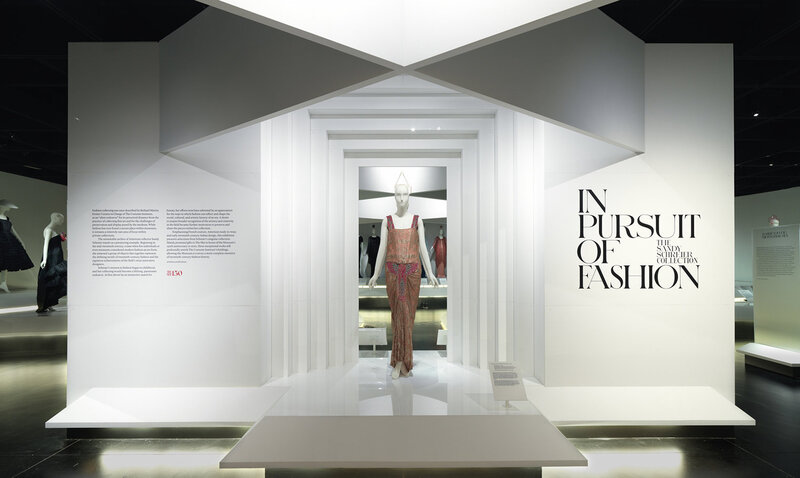
In Pursuit of Fashion: The Sandy Schreier Collection at The Met Fifth Avenue, November 27, 2019–May 17, 2020 © The Metropolitan Museum of Art.
Sandy Schreier has described her initial approach to collecting as simply seeking beauty. However, her instinctive response to the objects she encountered in these early years was influenced by sources of inspiration that would continue to shape her collecting, notably Hollywood film and her childhood introduction to fashion through the Detroit specialty store Russeks, where her father worked in the 1930s and 1940s.
At Russeks, she was exposed to leading periodicals such as Vogue and Harper's Bazaar, which guided her knowledge of fashion. Schreier also received her first "acquisitions" as gifts from clients of the elegant shop. As she developed her collection, she continued to seek out opportunities to acquire compelling pieces from the wardrobes of stylish women, such as Elizabeth Parke Firestone.
Simultaneously, film costume of Hollywood's so-called Golden Age stimulated a preference for glamour and drama that is especially evident in Schreier's outstanding collection of mid-century American and French fashions. The distinctively American glamour she admired in film costume is echoed in designs by Gilbert Adrian and other innovative American couturiers, while her taste for fashions that impart drama is similarly reflected in postwar French couture.

Evening Dress, Cristóbal Balenciaga (Spanish, 1895 – 1972) for House of Balenciaga (French, founded 1937), summer 1961; Promised gift of Sandy Schreier. Photo © Nicholas Alan Cope / Courtesy of the Metropolitan Museum of Art.

Evening Dress, Gilbert Adrian (American, 1903–1959), fall 1945; Promised gift of Sandy Schreier. Photo © Nicholas Alan Cope / Courtesy of the Metropolitan Museum of Art.

Gallery view, “In Pursuit of Beauty: Origins of a Collection.” © The Metropolitan Museum of Art.
The Past Recaptured: Fortuny and Gallenga
For Sandy Schreier, an early stimulus for thinking about fashion as an art form came through regular childhood visits to the Detroit Institute of Arts. Paintings that featured magnificently rendered dress and textiles became a catalyst for her interest in fashion and for her later appreciation of designers whose garments are defined by their exquisite fabrics. This collecting interest is represented by an exceptional array of designs by Mariano Fortuny y Madrazo and Maria Monaci Gallenga, both of whom worked in Italy in the early decades of the twentieth century and are among the first designers Schreier collected. Viewing themselves as artists, they approached dress from outside the traditional fashion system.
Marcel Proust, in the novel In Search of Lost Time (1913), described Fortuny gowns as "faithfully antique but markedly original." Proust captured the duality of Fortuny's work, which engaged deeply with the past but also spoke powerfully of timelessness and modernity. Fortuny's approach to dress influenced a number of his contemporaries, including Gallenga. Like Fortuny, Gallenga created garments that showcase luxurious textiles printed with designs adapted from historical sources. Their fashions were initially most appreciated by individuals within the art world but grew to have broader appeal for their artfully designed fabrics and simple lines.

Jacket, Mariano Fortuny y Madrazo (Spanish, 1871–1949), 1920s–30s; Promised gift of Sandy Schreier. Image courtesy of The Metropolitan Museum of Art, Photo: Nicholas Alan Cope.

Mariano Fortuny y Madrazo (Spanish, 1871–1949). Coat, 1920s-30s. Brown and gree silk velvet on silk-cotton ground printed with metallic pigment. “Delphos” dress, 1920s–30s. Pleated green silk charmeuse, navy silk cord, and brown-and-white glass beads; Promised gift of Sandy Schreier. Image courtesy of The Metropolitan Museum of Art, Photo: Nicholas Alan Cope.

Monica Monaci Gallenga (Italian, 1880–1944). Tea gown, 1920s. Black and blue-green silk velvet printed with metallic pigment, black silk cord, and polychrome glass beads; Promised gift of Sandy Schreier. Image courtesy of The Metropolitan Museum of Art, Photo: Nicholas Alan Cope.
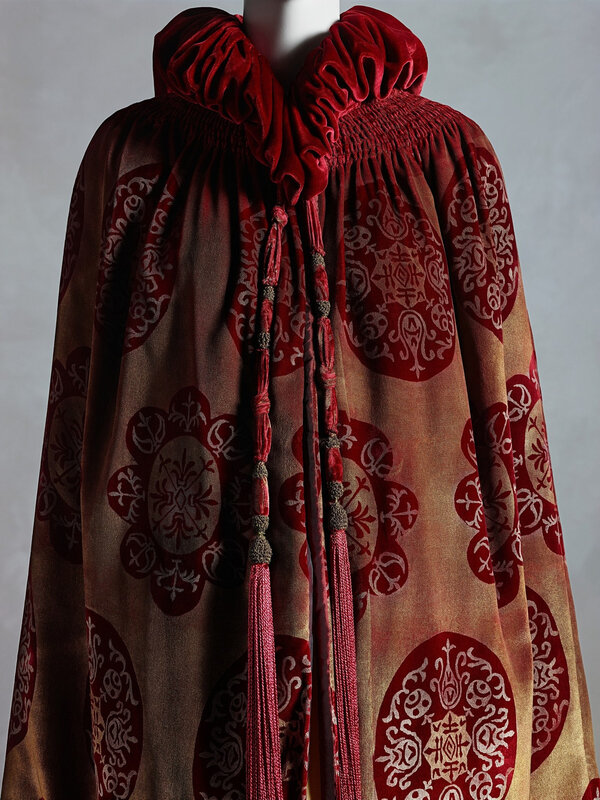
Evening Cape, Maria Monaci Gallenga (Italian, 1880–1944), ca. 1925; Promised gift of Sandy Schreier. Photo © Nicholas Alan Cope / Courtesy of the Metropolitan Museum of Art.

Gallery view, “The Past Recaptured: Fortuny and Gallenga.” © The Metropolitan Museum of Art.
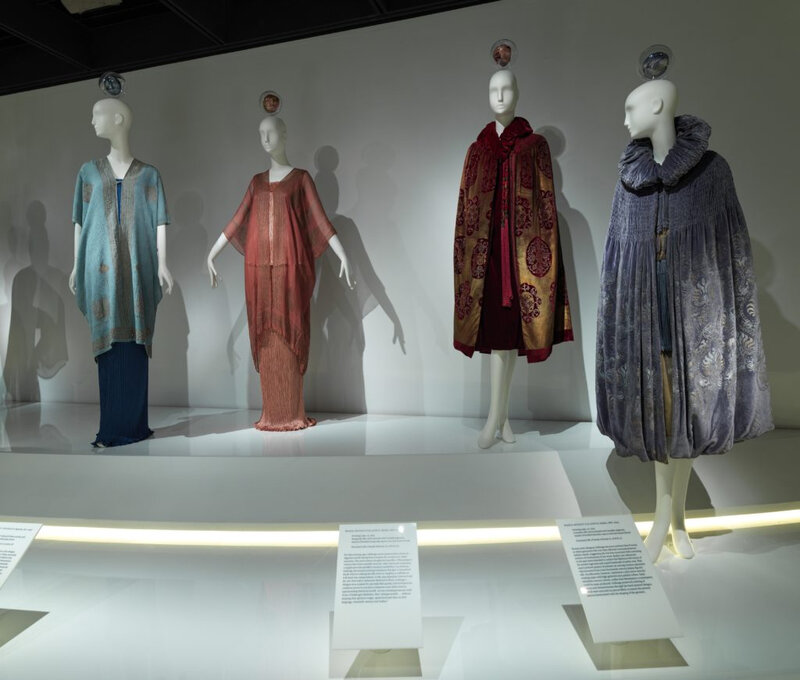
Gallery view, “The Past Recaptured: Fortuny and Gallenga.” © The Metropolitan Museum of Art.
Splendid examples of 1910s, 1920s, and 1930s eveningwear—a particular strength of Sandy Schreier's collection—embody l'esprit nouveau ("the modern spirit") and express the vitality of the age. Characterized by innovative silhouettes and creative embellishment, these fashions attest to the superb capabilities of the specialist embroiderers, pleaters, feather workers, and lace and flower makers operating at their height in advance of World War II.
French and American clothing from the interwar years also signals the accompanying social and artistic upheaval of the era. Outlets of leisure and entertainment such as movie theaters and nightclubs became popular sites of escapism and celebration following victory in World War I, and in 1920 the Nineteenth Amendment was passed, granting American women the right to vote. Changes in lifestyle were reflected in women's dress as undergarments became increasingly streamlined, cumbersome layers were reduced, and garment cuts and lengths oscillated throughout the period. During this seminal moment of change, notions of beauty and modernity developed in tandem, and fashion was led primarily by a coterie of female designers. Works by many of these women are featured here.
Splendid examples of 1910s, 1920s, and 1930s eveningwear—a particular strength of Sandy Schreier's collection—embody l'esprit nouveau ("the modern spirit") and express the vitality of the age. Characterized by innovative silhouettes and creative embellishment, these fashions attest to the superb capabilities of the specialist embroiderers, pleaters, feather workers, and lace and flower makers operating at their height in advance of World War II.
French and American clothing from the interwar years also signals the accompanying social and artistic upheaval of the era. Outlets of leisure and entertainment such as movie theaters and nightclubs became popular sites of escapism and celebration following victory in World War I, and in 1920 the Nineteenth Amendment was passed, granting American women the right to vote. Changes in lifestyle were reflected in women's dress as undergarments became increasingly streamlined, cumbersome layers were reduced, and garment cuts and lengths oscillated throughout the period. During this seminal moment of change, notions of beauty and modernity developed in tandem, and fashion was led primarily by a coterie of female designers. Works by many of these women are featured here.

Evening Dress, Jeanne Victorine Margaine-Lacroix (French, 1868–1930) for Maison Margaine-Lacroix (French, active ca. 1889– 1929), ca. 1913; Promised gift of Sandy Schreier. Image courtesy of The Metropolitan Museum of Art, Photo: Nicholas Alan Cope.

Dress, Madeleine & Madeleine (French, 1919–26), 1923; Promised gift of Sandy Schreier. Photo © Nicholas Alan Cope / Courtesy of the Metropolitan Museum of Art

Evening Dress, probably French, ca. 1925–28; Promised gift of Sandy Schreier. Photo © Nicholas Alan Cope / Courtesy of the Metropolitan Museum of Art

Evening Dress, Madeleine Vionnet (French, 1876–1975), spring 1931; Promised gift of Sandy Schreier. Photo © Nicholas Alan Cope / Courtesy of the Metropolitan Museum of Art.

Necklace, Maison Gripoix (French, founded 1869) for House of Chanel (French, founded 1913), ca. 1938; Promised gift of Sandy Schreier. Photo © Nicholas Alan Cope / Courtesy of the Metropolitan Museum of Art.
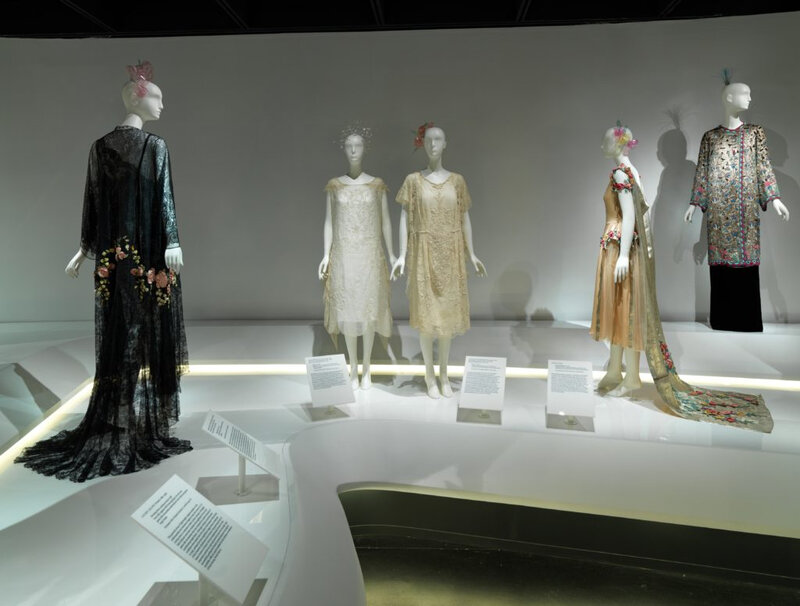
Gallery view, “L’Esprit Nouveau: The Interwar Era.” © The Metropolitan Museum of Art.

Gallery view, “L’Esprit Nouveau: The Interwar Era.” © The Metropolitan Museum of Art.

Gallery view, “L’Esprit Nouveau: The Interwar Era.” © The Metropolitan Museum of Art.
Early twentieth-century fashion often served as a medium to showcase superior technique, echo social conventions, and convey notions of glamour and beauty. Contemporary clothing following World War II frequently expanded on this tradition, acting as a vehicle for narrative-driven design. The objects in this gallery reflect a strand of Sandy Schreier's collecting that attests to the ability of fashion to not only mirror the tastes and mores of a period but also function as a conduit for dialogue.
These lively designs are conversant with the zeitgeist yet draw on historical dress, art, and popular culture through references that include biography, humor, and quotation. Just as the garments express the distinct personalities of their makers, their assemblage here reveals the individuality and eye of their collector. Though the pieces span a period of sixty years, they are united in their embrace of fashion for its storytelling ability.

Evening Dress, Jean Dessès (French, born Egypt, 1904– 1970), fall/winter 1953–54; Promised gift of Sandy Schreier. Photo © Nicholas Alan Cope / Courtesy of the Metropolitan Museum of Art.

Evening Ensemble, Cristóbal Balenciaga (Spanish, 1895–1972) for House of Balenciaga (French, founded 1937), ca. 1956; Promised gift of Sandy Schreier. Photo © Nicholas Alan Cope / Courtesy of the Metropolitan Museum of Art.

“Du Barry” Evening Dress, Christian Dior (French, 1905–1957) for House of Dior (French, founded 1947), fall/winter 1957–58; Promised gift of Sandy Schreier. Photo © Nicholas Alan Cope / Courtesy of the Metropolitan Museum of Art.

Ensemble, Yves Saint Laurent (French, born Algeria, 1936– 2008) for House of Dior (French, founded 1947), spring/summer 1958; Promised gift of Sandy Schreier. Photo © Nicholas Alan Cope / Courtesy of the Metropolitan Museum of Art.

Zandra Rhodes (British, born 1940). Ensemble, spring/summer 1976. Polychrome-printed blue silk chiffon embroidered with blue floral sequins; blue silk jersey; Promised gift of Sandy Schreier. Photo © Nicholas Alan Cope / Courtesy of the Metropolitan Museum of Art.
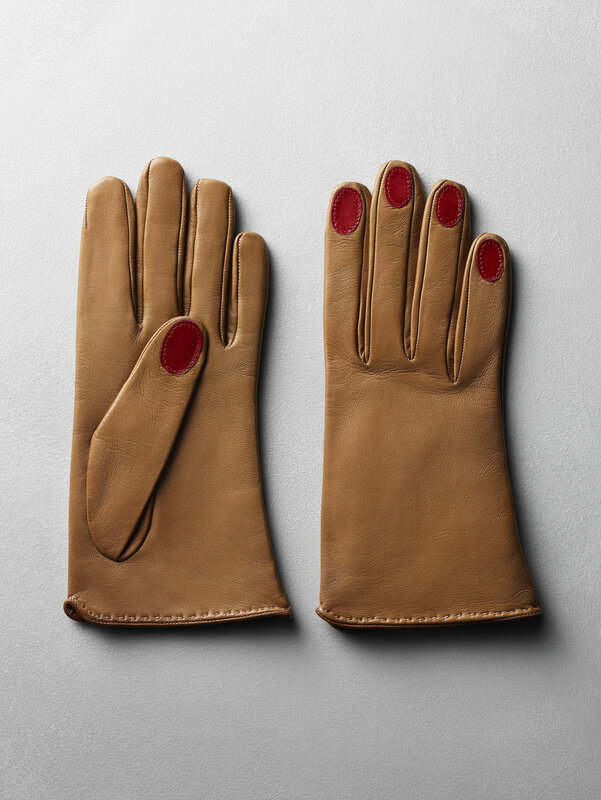
Gloves, Franco Moschino (Italian, 1950–1994) for Moschino Couture (Italian, founded 1983), 1980s; Promised gift of Sandy Schreier. Image courtesy of The Metropolitan Museum of Art, Photo: Nicholas Alan Cope.
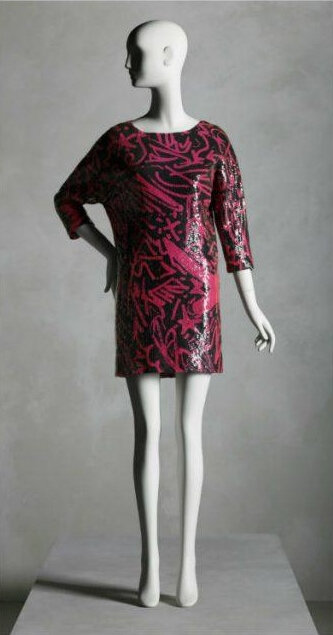
Stephen Sprouse (American, 1953–2004). Dress, autumn/winter 1983–84. Black-and-pink printed silk crepe embroidered with clear sequins; Promised gift of Sandy Schreier. Image courtesy of The Metropolitan Museum of Art, Photo: Nicholas Alan Cope.

Dress, Karl Lagerfeld (French, born Germany, 1938–2019) for Chloé (French, founded 1952), spring/summer 1984; Promised gift of Sandy Schreier. Photo © Nicholas Alan Cope / Courtesy of the Metropolitan Museum of Art.

Ensemble, Patrick Kelly (French, born America, 1954–1990), autumn/winter 1988–89; Promised gift of Sandy Schreier. Photo © Nicholas Alan Cope / Courtesy of the Metropolitan Museum of Art

"Breakfast” Suit, Christian Francis Roth (American, born 1969), spring/summer 1990; Promised gift of Sandy Schreier. Photo © Nicholas Alan Cope / Courtesy of the Metropolitan Museum of Art.

Moschino Cheap and Chic (Italian, founded 1988). Franco Moschino (Italian, 1950–1994). “Art Is Love” dress, spring/summer 1993. Ivory, red, blue, yellow, and black silk crepe embroidered with black silk cord; Promised gift of Sandy Schreier. Photo © Nicholas Alan Cope / Courtesy of the Metropolitan Museum of Art.

Philip Treacy (British, born Ireland, 1966). Hat, spring 2003 haute couture; Promised gift of Sandy Schreier. Photo © Nicholas Alan Cope / Courtesy of the Metropolitan Museum of Art.

Isaac Mizrahi (American, born 1961). Hat, autumn/winter 2009–10; Promised gift of Sandy Schreier. Photo © Nicholas Alan Cope / Courtesy of the Metropolitan Museum of Art.

Gallery view, “The Message Is the Medium: Fashion that Speaks.” © The Metropolitan Museum of Art.

Gallery view, “The Message Is the Medium: Fashion that Speaks.” © The Metropolitan Museum of Art.

/https%3A%2F%2Fprofilepics.canalblog.com%2Fprofilepics%2F1%2F0%2F100183.jpg)
/https%3A%2F%2Fstorage.canalblog.com%2F03%2F02%2F119589%2F96711876_o.jpg)
/https%3A%2F%2Fstorage.canalblog.com%2F11%2F31%2F119589%2F94773502_o.jpg)
/https%3A%2F%2Fstorage.canalblog.com%2F20%2F83%2F119589%2F94772815_o.jpg)
/https%3A%2F%2Fstorage.canalblog.com%2F26%2F72%2F119589%2F75604929_o.jpg)
/https%3A%2F%2Fstorage.canalblog.com%2F59%2F60%2F119589%2F26458628_o.jpg)


/http%3A%2F%2Fstorage.canalblog.com%2F89%2F93%2F119589%2F127899898_o.jpg)
/http%3A%2F%2Fstorage.canalblog.com%2F35%2F20%2F119589%2F126086842_o.jpg)
/http%3A%2F%2Fstorage.canalblog.com%2F84%2F63%2F119589%2F120641874_o.jpg)
/http%3A%2F%2Fstorage.canalblog.com%2F43%2F82%2F119589%2F120569495_o.jpg)